132 Identify horizontal asymptotes
While vertical asymptotes describe the behavior of a graph as the output gets very large or very small, horizontal asymptotes help describe the behavior of a graph as the input gets very large or very small. Recall that a polynomial’s end behavior will mirror that of the leading term. Likewise, a rational function’s end behavior will mirror that of the ratio of the leading terms of the numerator and denominator functions.
There are three distinct outcomes when checking for horizontal asymptotes:
Case 1: If the degree of the denominator > degree of the numerator, there is a horizontal asymptote at y = 0.
In this case, the end behavior is [latex]fleft(xright)approx frac{4x}{{x}^{2}}=frac{4}{x}\[/latex]. This tells us that, as the inputs increase or decrease without bound, this function will behave similarly to the function [latex]gleft(xright)=frac{4}{x}\[/latex], and the outputs will approach zero, resulting in a horizontal asymptote at y = 0. Note that this graph crosses the horizontal asymptote.
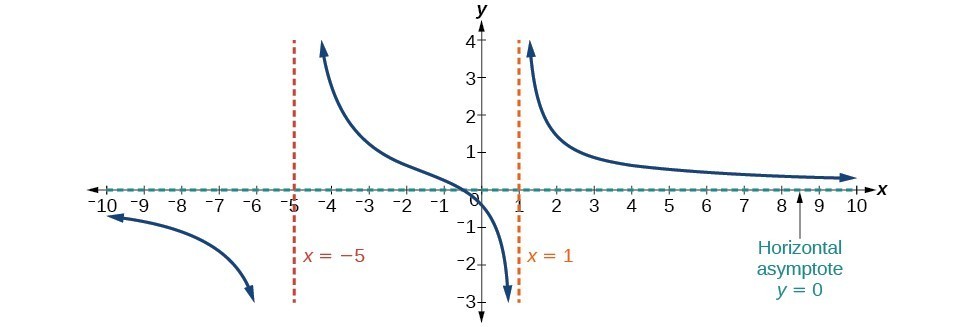
Figure 12. Horizontal Asymptote y = 0 when [latex]fleft(xright)=frac{pleft(xright)}{qleft(xright)},qleft(xright)ne{0}text{ where degree of }p Case 2: If the degree of the denominator < degree of the numerator by one, we get a slant asymptote. In this case, the end behavior is [latex]fleft(xright)approx frac{3{x}^{2}}{x}=3x\[/latex]. This tells us that as the inputs increase or decrease without bound, this function will behave similarly to the function [latex]gleft(xright)=3x\[/latex]. As the inputs grow large, the outputs will grow and not level off, so this graph has no horizontal asymptote. However, the graph of [latex]gleft(xright)=3x\[/latex] looks like a diagonal line, and since f will behave similarly to g, it will approach a line close to [latex]y=3x\[/latex]. This line is a slant asymptote. To find the equation of the slant asymptote, divide [latex]frac{3{x}^{2}-2x+1}{x - 1}\[/latex]. The quotient is [latex]3x+1\[/latex], and the remainder is 2. The slant asymptote is the graph of the line [latex]gleft(xright)=3x+1\[/latex]. Figure 13. Slant Asymptote when [latex]fleft(xright)=frac{pleft(xright)}{qleft(xright)},qleft(xright)ne 0\[/latex] where degree of [latex]p>text{ degree of }qtext{ by }1\[/latex]. Case 3: If the degree of the denominator = degree of the numerator, there is a horizontal asymptote at [latex]y=frac{{a}_{n}}{{b}_{n}}\[/latex], where [latex]{a}_{n}[/latex] and [latex]{b}_{n}\[/latex] are the leading coefficients of [latex]pleft(xright)\[/latex] and [latex]qleft(xright)\[/latex] for [latex]fleft(xright)=frac{pleft(xright)}{qleft(xright)},qleft(xright)ne 0\[/latex]. In this case, the end behavior is [latex]fleft(xright)approx frac{3{x}^{2}}{{x}^{2}}=3\[/latex]. This tells us that as the inputs grow large, this function will behave like the function [latex]gleft(xright)=3\[/latex], which is a horizontal line. As [latex]xto pm infty ,fleft(xright)to 3\[/latex], resulting in a horizontal asymptote at y = 3. Note that this graph crosses the horizontal asymptote. Figure 14. Horizontal Asymptote when [latex]fleft(xright)=frac{pleft(xright)}{qleft(xright)},qleft(xright)ne 0text{where degree of }p=text{degree of }q\[/latex]. Notice that, while the graph of a rational function will never cross a vertical asymptote, the graph may or may not cross a horizontal or slant asymptote. Also, although the graph of a rational function may have many vertical asymptotes, the graph will have at most one horizontal (or slant) asymptote. It should be noted that, if the degree of the numerator is larger than the degree of the denominator by more than one, the end behavior of the graph will mimic the behavior of the reduced end behavior fraction. For instance, if we had the function with end behavior the end behavior of the graph would look similar to that of an even polynomial with a positive leading coefficient. The horizontal asymptote of a rational function can be determined by looking at the degrees of the numerator and denominator. For the functions below, identify the horizontal or slant asymptote. For these solutions, we will use [latex]fleft(xright)=frac{pleft(xright)}{qleft(xright)}, qleft(xright)ne 0\[/latex]. The quotient is [latex]x - 2\[/latex] and the remainder is 13. There is a slant asymptote at [latex]y=-x - 2\[/latex]. In the sugar concentration problem earlier, we created the equation [latex]Cleft(tright)=frac{5+t}{100+10t}\[/latex]. Find the horizontal asymptote and interpret it in context of the problem. Both the numerator and denominator are linear (degree 1). Because the degrees are equal, there will be a horizontal asymptote at the ratio of the leading coefficients. In the numerator, the leading term is t, with coefficient 1. In the denominator, the leading term is 10t, with coefficient 10. The horizontal asymptote will be at the ratio of these values: This function will have a horizontal asymptote at [latex]y=frac{1}{10}\[/latex]. This tells us that as the values of t increase, the values of C will approach [latex]frac{1}{10}\[/latex]. In context, this means that, as more time goes by, the concentration of sugar in the tank will approach one-tenth of a pound of sugar per gallon of water or [latex]frac{1}{10}\[/latex] pounds per gallon. Find the horizontal and vertical asymptotes of the function First, note that this function has no common factors, so there are no potential removable discontinuities. The function will have vertical asymptotes when the denominator is zero, causing the function to be undefined. The denominator will be zero at [latex]x=1,-2,text{and }5\[/latex], indicating vertical asymptotes at these values. The numerator has degree 2, while the denominator has degree 3. Since the degree of the denominator is greater than the degree of the numerator, the denominator will grow faster than the numerator, causing the outputs to tend towards zero as the inputs get large, and so as [latex]xto pm infty , fleft(xright)to 0\[/latex]. This function will have a horizontal asymptote at [latex]y=0\[/latex]. Find the vertical and horizontal asymptotes of the function: [latex]fleft(xright)=frac{left(2x - 1right)left(2x+1right)}{left(x - 2right)left(x+3right)}\[/latex] A rational function will have a y-intercept when the input is zero, if the function is defined at zero. A rational function will not have a y-intercept if the function is not defined at zero. Likewise, a rational function will have x-intercepts at the inputs that cause the output to be zero. Since a fraction is only equal to zero when the numerator is zero, x-intercepts can only occur when the numerator of the rational function is equal to zero. Find the intercepts of [latex]fleft(xright)=frac{left(x - 2right)left(x+3right)}{left(x - 1right)left(x+2right)left(x - 5right)}\[/latex]. We can find the y-intercept by evaluating the function at zero The x-intercepts will occur when the function is equal to zero: The y-intercept is [latex]left(0,-0.6right)\[/latex], the x-intercepts are [latex]left(2,0right)\[/latex] and [latex]left(-3,0right)\[/latex]. Given the reciprocal squared function that is shifted right 3 units and down 4 units, write this as a rational function. Then, find the x– and y-intercepts and the horizontal and vertical asymptotes.
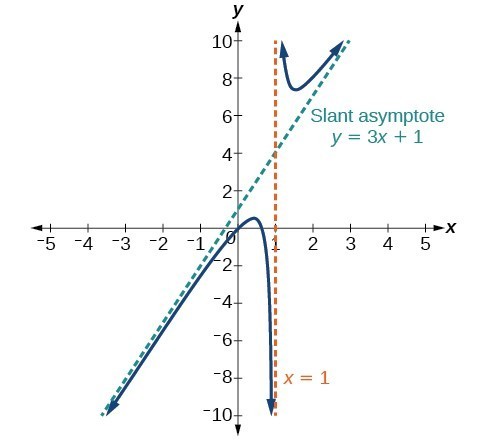
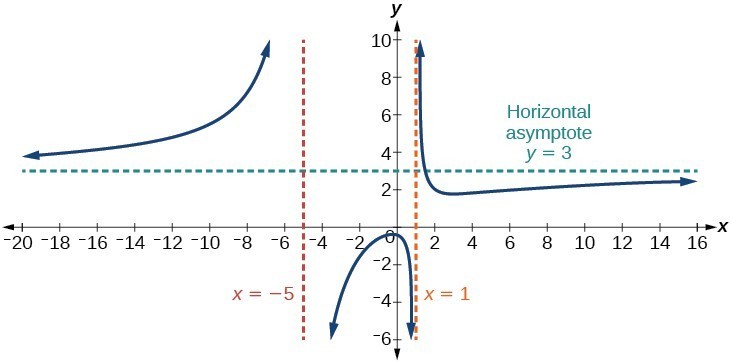
A General Note: Horizontal Asymptotes of Rational Functions
Example 7: Identifying Horizontal and Slant Asymptotes
Solution
Example 8: Identifying Horizontal Asymptotes
Solution
Example 9: Identifying Horizontal and Vertical Asymptotes
Solution
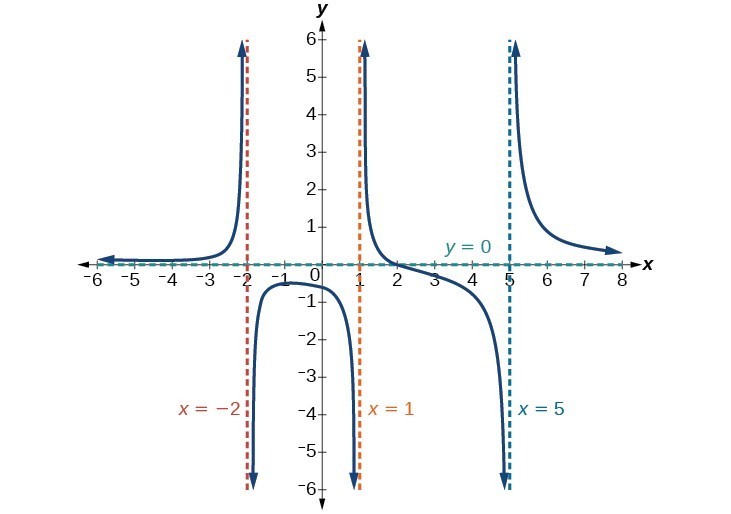
Try It 6
A General Note: Intercepts of Rational Functions
Example 10: Finding the Intercepts of a Rational Function
Solution
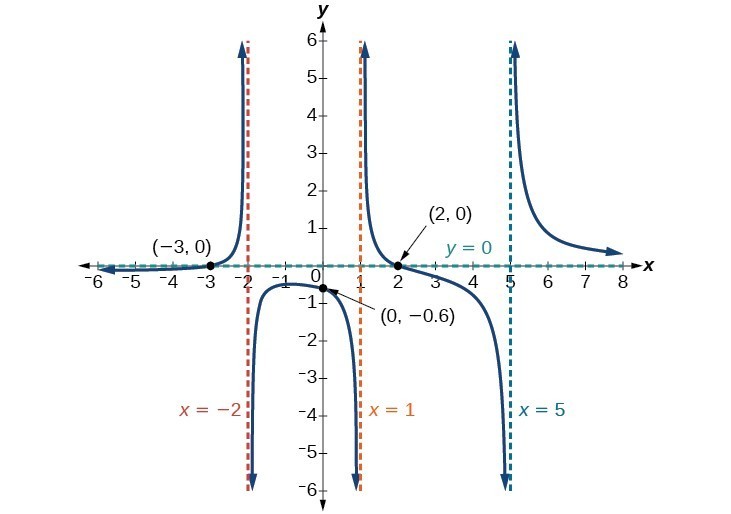
Try It 7

